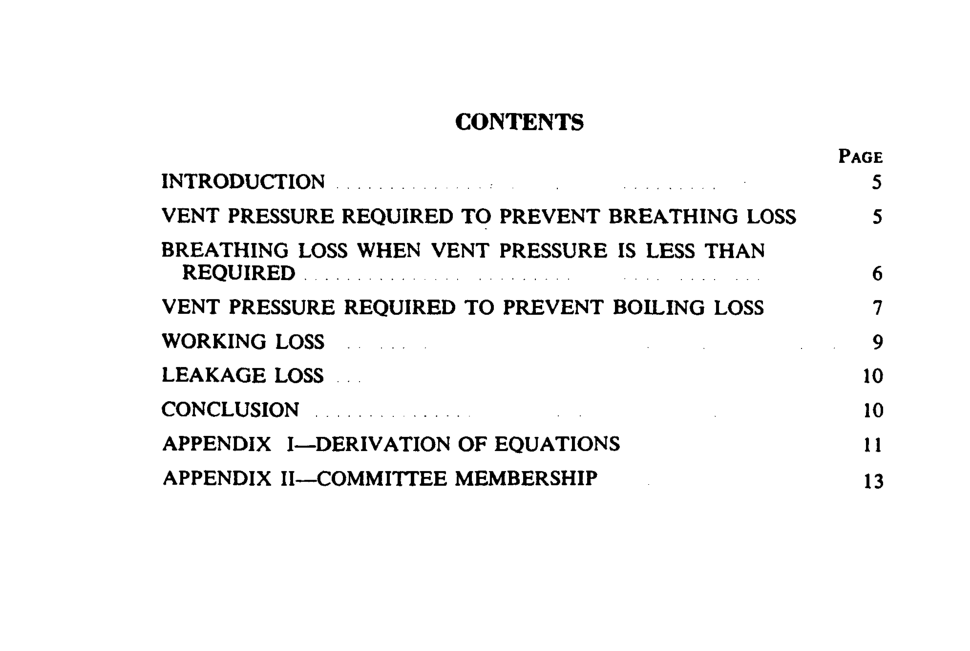API Bull 2516 pdf download

API Bull 2516 pdf download.Evaporation Loss From Low- Pressure Tanks
The term low-pressure tank, as used in this evapora- tion loss bulletin, refers to vessels having a maximum pressure vent setting in the range from just above atmospheric pressure to 15 psig and a vacuum vent setting normally 1 to 2 0z per sq in. The tanks are used for the storage of products, such as motor gaso- line,,pentanes, and natural gasolines, having a Reid vapor pressure up to 30 lb. Although a storage pressure of less than 2.5 psig may be used for some products, the type of vessel construction does not permit appre- ciable economy by using lower design pressures. The loss principles applying to 2.5-psig to 15-psig pressure will also apply for higher or lower working pressures than the specified range. Low-pressure tanks are con- structed in many sizes and shapes, depending upon the operating pressure range. Fig. 1, 2, 3, and 4 show typical types of construction. Pressure tanks differ from other conservation tanks in that they have neither moving parts nor a variable vapor space. The principle of operation is the same as that for the conservation vented fixed-roof tank. The basic difference is the ability of low-pressure tanks to withstand higher pressure variations. Because of this, venting loss due to boiling and breathing loss due to daily temperature changes are prevented. By increas- ing the tank design pressure, liquids of higher volatility may be stored without breathing loss. The amount of loss from pressure storage tanks has been considered by users and tank manufacturers, but few data are available. Therefore, a theoretical basis has been used to estimate losses resulting from various storage conditions and types of products. Four types of losses are considered: breathing loss, boiling loss, working loss, and leakage loss. Factors are discussed that affect the performance of low-pressure tank storage.
The relation in equation (1) applies only when the vapor pressure of the liquid at minimum surface tem- perature (p;) is less than the absolute pressure (P1+ Po) at which the vacuum vent opens. Under this condition air is always present in the vapor space. The breathing curve shown in Fig. 5 is a plot of equation (1) and gives the pressure (P2) calculated to eliminate breath- ing losses for products ranging up to 17.5 psia TVP at 100 F with storage at sea-level atmospheric pressure. Products having a true vapor pressure above 17.5 psia are subjected to boiling losses; these products are dis- cussed in a subsequent section. The Fig. 5 plot of equation (1) is for the condition where P;= 0.0 psig. The value of p, corresponding to P: was obtained from the vapor pressure chart, Fig. 6. A range of ditillation slopes was used ; i.e. S=3 for the condition p:=8 to S=1 for the condition p,= 17.5, because the higher vapor pressure stocks tend to have a smaller slope. Altitude will affect the required storage pressure. Adjustment of storage pressures for atmospheric pres- sures other than 14.7 psia may be made by substituting the proper atmospheric pressure (Pa) in equation (1). Table 1 lists the atmospheric pressure existing at various altitudes.
Working loss will occur during flling if the pressure of the vapor space exceeds the vent setting and vapors are expelled. If the pressure at the start of flling is less than the pressure vent setting, the air-hydrocarbon mixture will be compressed during flling. The hydro- carbon condenses maintaining nearly a constant partial pressure. A. certain fraction of .vapor space may be flled with liquid before the vent opens, thus decreasing working loss. As flling continues, the total pressure eventually equals the pressure at which the relief valve opens, resulting in venting. Assuming there is no tem- perature change in either the liquid or the vapor during the flling period, the remaining liquid entering the tank replaces an equal volume of vapors discharged from the vent. The total amount of loss, therefore, depends on the capacity of the vapor space in the tank. Since the temperature normally does change as conden- sation takes place, the rate of flling and emptying can also affect the amount of loss. The unpredictable effect of these variables has made it difcult to determine the actual loss resulting from filling low-pressure tanks.









